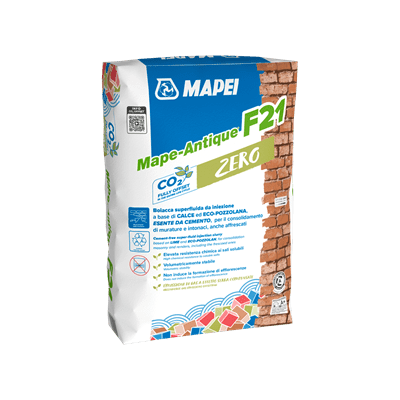
The Church of the Nativity in Bethlehem
The precarious state of the roof and water seepage in the church were heavily damaging the plaster, the mosaics and the floor of the Church of Bethlehem, one of the oldest and most visited churches in the world.
In 2013 a detailed restoration project started, involving highly specialised experts, teams and products - among which Mapei MAPEWOOD product line for the restoration of wooden structures, and MAPE-ANTIQUE F21 for masonries consalidation where some of the tiles had become detached from the substrate.
Restoration work on the Church of the Nativity in Bethlehem – one of the most popular sites for pilgrims visiting the Holy Land – started in September 2013 and is still in progress. Along with Piacenti SpA from Prato (Central Italy), the company which directed and carried out the consolidation work, Mapei and its products and systems for strengthening and restoring wooden structures played an active part on this complicated and particularly significant site.
Restoration work on the Church of the Nativity in Bethlehem – one of the most popular sites for pilgrims visiting the Holy Land – started in September 2013 and is still in progress.
Along with Piacenti SpA from Prato (Central Italy), the company which directed and carried out the consolidation work, Mapei and its products and systems for strengthening and restoring wooden structures played an active part on this complicated and particularly significant site.
The prestigious basilica is one of the most antique Christian churches and is steeped in spirituality. It was built around 330 AD by Emperor Constantine and his mother Elena on the ruins of an ancient Pagan temple, where the first Christians celebrated the birth of Jesus. Rebuilt and extended in the 6th century by Emperor Justinian I, it was modified again during the Crusades era and then again over the following centuries, and is today a monument of considerable historical and artistic significance.
Over the course of the centuries a Franciscan convent, an Orthodox monastery and an Armenian monastery were built around the structure. This is why there are now three different Churches (Roman Catholic, Greek Orthodox and Armenian) jointly administering this place of worship which, since 2012, has been an UNESCO World Heritage Site.
The recent restoration work on this symbol of Christianity has never interrupted the wave of pilgrims visiting the Church, which is why this site stands out in particular for the complexity of the logistical operations to manage and carry out the work, made even more difficult by the range of skills required to carry out the work and the organisation and transfer of all the resources required for the work.
There is a condition of Status Quo of the Holy Land Sites inside the Church to accommodate the rights and jurisdiction of each of the three religious communities (Greek Orthodox, Catholic represented by the Order of Franciscan missionaries serving the Holy Land, and Armenian Orthodox), with which the main contractor had to interface on a regular basis.
It was only thanks to a delicate and complicated work of coordination and dialogue, involving the Palestinian authorities, that it was possible to develop an articulated, organic study and a research, structural upgrading and restoration programme for the internal and external decorative and structural features of the Church over the last six years.
The uniqueness of this important historical site, along with the significance of the project, meant that the study and specification phase of the construction details of the building, the materials used to build the church and their state of conservation, had to be particularly detailed and complex.
A document published in 2000 by UNESCO (Wenzel-Szaktilla-Pliett 2000) had already highlighted the precarious state of the roof and the subsequent damage it had caused, due to water seepage in the church and on the plaster, the mosaics and the floor. A fully documented report from 2010 on the level of damage of the church was published by a multi-disciplined task-force coordinated by the Ferrara Research Consortium of the University of Ferrara (Central Italy), with the aim of developing a restoration project.
On the 26th of August 2013 Piacenti SpA, which had been selected following an international tender, signed a contract to carry out the restoration and conservation work on the roof by restoring the physical and mechanical functions of the timber roof structure and replacing 2,000 m2 of lead sheeting on the roof.
The same company was then awarded a contract to carry out further work: restoration of the internal and external stone surfaces and renders of the church, the valuable wall mosaics, the ante-chamber near the entrance to the church, the main wooden and metal doors to the church and the wooden architraves of the colonnade.
The work was contracted out by the Palestinian National Authority which delegated the work to a Presidential Committee. Among the sponsors one finds more than 26 Christian and non-Christian countries, private citizens and bodies and various Palestinian banks. 64 different companies and numerous experts took part in the project, amounting to a total of more than 170 people.
A SITE THAT NEVER STOPS
There are currently four different teams operating on the site, made up of highly specialised Italian craftsmen coordinated by a technical team based in Bethlehem, which are also supported by a similar number of technicians based in the Piacenti SpA’s headquarters in Italy.
This site requires constant, ongoing control and coordination and maximum efficiency in order to keep in line with the work schedule, as well as to compile documentation on a daily basis to record all the areas covered, the products used and the way the actual work has been carried out.
Development work on all the materials used to build the church and the way they are treated has required very thorough research work through in-depth preliminary diagnostics and testing, often requiring the intervention and support of expert consultants with knowledge of specific fields of restoration, to help overcome problems regarding the main characteristics of the actual building, structural engineering, diagnostic analysis, the reconstruction of historical/construction events over the years, etc.
Numerous problems have arisen over the years, both while setting up the site and when actually carrying out the numerous, complex types of intervention: from the preparation and positioning of the scaffolding (for which multi-directional scaffolding imported from Italy was used to make the work areas more comfortable and to provide access to all the areas of the church) to the development of special operational technology and equipment for the roof (where a special air chamber was created to allow ventilation between each layer), and from the timber truss structure of the roof (where the damaged and deteriorated portions were replaced with implants made from the same type of antique wood using a bespoke procedure developed for the type of structure and wood actually found on site) to the decorated surfaces (which were carefully studied through archeometric analysis and then treated with a targeted consolidation, cleaning and integration cycle using the most up-to-date methods).
DIAGNOSTIC ANALYSIS AND TESTING TO CHOOSE MAPEI
As far as the materials used in this intervention are concerned, they were chosen by carrying out a series of preliminary laboratory tests and on-site testing to make sure they complied with the specified thermal and hygrometric requirements, as well as they were able to withstand the loads and stresses acting on them. Going into detail, the structural strengthening work on the timber truss roof, which was carried out by inserting implants and anchor points, required meticulous work to write the procedures, perfect the operational methods, choose and verify the materials by carrying out a diagnostic survey.
Following the analysis, which was carried out by comparing the results of the monitoring campaign by LegnoDoc Srl from Central Italy and the samples taken, the product chosen to bond the wooden structures and the connector rods of an appropriate diameter inserted into the structures was MAPEWOOD PASTE 140 two-component, thixotropic epoxy adhesive. This product is the ideal solution for repairing timber beams and truss by anchoring metal bars to them, because it hardens without shrinking and forms a paste with exceptional bonding properties, high levels of tensile and flexural strength and a flexural modulus of elasticity that ensures a sound structural joint is formed.
The results were only obtained after impregnating the surfaces with MAPEWOOD PRIMER 100, an epoxy impregnator in water dispersion used to consolidate wooden structural elements damaged by fungi or woodworms. This product is specific for priming the end-parts of structural elements in high density wooden beams, truss elements and pillars (such as oak and chestnut) that need to be repaired by grafting inserts bonded with MAPEWOOD PASTE 140 or MAPEWOOD GEL 120.
The latter product, an epoxy adhesive used for the structural consolidation of wooden elements by bonding grafted inserts, was also used on site to bond new wooden parts to the existing wooden structure.
Once MAPEWOOD GEL 120 has been mixed, it is easy to apply and hardens without shrinking, to form a compound with exceptional bonding strength and compatibility with wood and excellent resistance to mechanical loads and stresses.
DECORATED AND RENDERED SURFACES
As with all the other work carried out, the procedures used to repair the renders and to treat the painted surfaces and mosaics were chosen, developed and verified following an exhaustive cognitive study to identify the forms and mechanisms of the ongoing deterioration and the technical and construction characteristics of the materials, so that the work would be carried out in a modulated way according to the type and level of deterioration, while guaranteeing the utmost care for the areas under repair.
A highly articulated, targeted plan of action was adopted to restore the mosaics on the walls and to repair and consolidate widespread areas with MAPE-ANTIQUE F21 superfluid, salt-resistant, fillerized hydraulic binder, where some of the tiles had become detached from the substrate. It also included the interventions to consolidate the surface of the glass tiles suffering from scattering, remove the deposits damaging the tiles and to carry out repairs on the missing areas.
The result is to have given a new voice and dignity to the mosaic decorations, which before the intervention had been severely compromised by seepage and, even more importantly, had become mute and degraded by the dark veil which hung over them.
Amongst the numerous surprises which came to light during the work, worthy of mention is the discovery of a portion of mosaic depicting an angel in its entirety, which had been hidden beneath the dull layer, dating back to the cycle of work carried out in the 13thcentury. A number of other testimonies of the past were also unearthed during the work in collaboration with a team of archaeologists.
And finally, also worthy of mention is the restoration of the decorative inlays in the wooden architrave running above the colonnade, which had been partially hidden by a layer of concretion, and the restoration of the finely crafted East Gate.
Today, at a distance of four years from the start of work on site, it is possible to appreciate the results of the superhuman efforts that have been made on the areas that have already been renovated.
In the meantime, restoration work is ongoing and the team working on the Church of the Nativity is searching for the most suitable solutions to guarantee the best care and protection for the monument.
I numeri del cantiere
170Partners, collaborators, subcontractors, consultants |
2.800m2 of scaffholding |
20Tonnes of ancient wood |
200kg of resin for wood |
55.000Screws just for the roof |
||||
2.000m2 of phenolic plywood |
2.800m2 of lead sheeting |
2Tonnes of Prato wool |
4Years of work |
130m2 of restored mosaic |
||||
1Armenian Gate restored |
2Renovated columns |
59World leaders on visit |






















